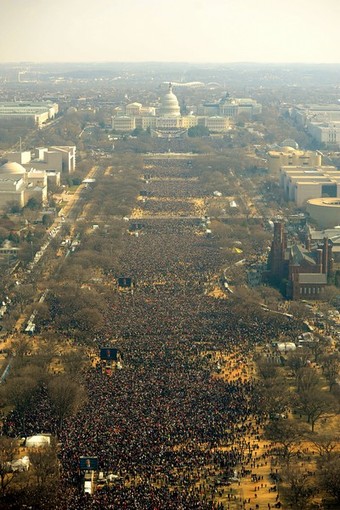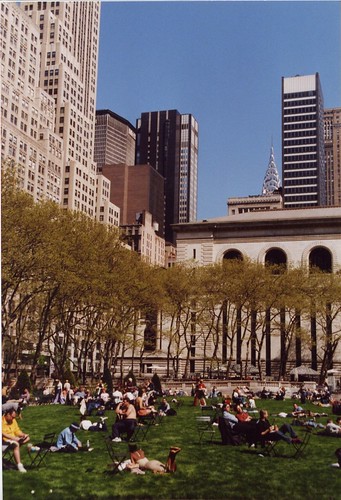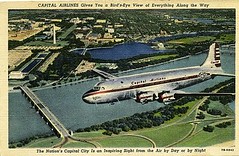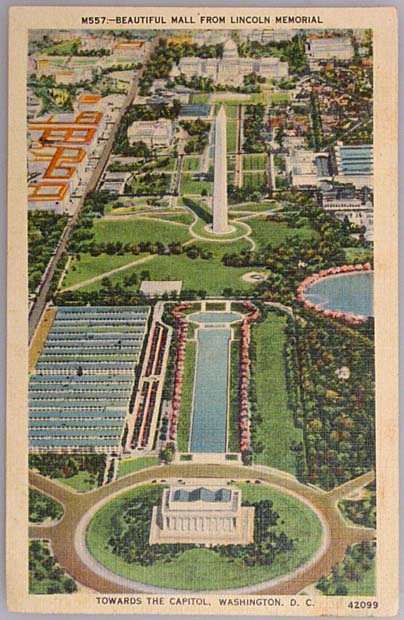More on the National Mall and the "National Experience" as mediated locally

WASHINGTON, D.C. - JANUARY 20: Crowds look towards the Capitol during the inauguration of Barack Obama as the 44th President of the United States of America on the National Mall January 20, 2009 in Washington, DC. Obama becomes the first African-American to be elected to the office of President in the history of the United States. (Photo by Emily Barnes/Getty Images)
Judy Scott Feldman's letter to the editor in yesterday's Post, "What We Can Do for the Mall," clued me into the op-ed in the Sunday Post, "The Future of the History Beneath Our Feet," by John Parsons, former associate director of the National Park Service, who during his tenure was responsible for most NPS activities within the City of Washington. (I haven't read Sunday's paper yet because I was away.) John disagrees with the position of the National Coalition to Save Our Mall calling for commission separate from the National Park Service to be responsible for the National Mall.
(Also see the editorial in today's Post, "A Downtrodden Mall," subtitled "America's front yard desperately needs sprucing up" and this piece from July 2008 in the Examiner, "Mall sprawl.")
I was thinking about this after reading Judy's letter...
First, a big problem with the "National Mall" is its "overuse" sure, but also that, like Congress, the National Park Service is relatively disconnected from having to be concerned about what other, especially local, constituencies think and are concerned about.
Second, from the perception of "users" of the Mall, since the most heavily used portion of the Mall is bracketed by the museums of the Smithsonian Institution as well as the National Gallery, it is key that the Museums be involved in managing this resource. (Of course, both the National Gallery and the Smithsonian Institution are disconnected from local input too--unless it comes from the Growth Machine designees, the Federal City Council.)
Third, it's clear that NPS has a hard time distinguishing a different set of needs between "urban" parks and what we might call the "traditional" nature-oriented (but definitely people influenced and shaped) "parks" such as Yellowstone or the Great Smokies. Urban parks might not have to worry about snowmobilers, but they do get a lot of use, need restrooms and other visitor service facilities, ought to have good food options, ought to allow food, etc.
The rehabilitation of Central Park, Bryant Park and other parks in New York City demonstrate how to go about improving the experience and utilization of urban parks--even if we can agree that perhaps Bryant Park gets overused by private events such as Fashion Week. (The park is managed by a public-private partnership and the partnership has to raise its own money to run the park, hence a focus on money-making events.)

Bryant Park, New York City.
But many of the things they do in places like Bryant Park or Madison Park in NYC "to make the park better" are not even allowed according to National Park Service regulations. The Project for Public Spaces led the revitalization of Bryant Park, and they have a book about the process,
Public Parks, Private Partners: How Partnerships Are Revitalizing Urban Parks. (Yes, there is the issue of "neoliberalism" and functional privatization of public spaces, but at the same time we have to recognize that quality spaces require extra efforts and funds that are often beyond the capability and capacity of local government to provide, although in this case, these extra efforts are beyond the capacity and funding of the National Park Service.)
Fourth, the concept of "heritage areas," including "National Heritage Areas" and how they are managed is directly relevant to how the National Park Service manages park installations within the City of Washington. NPS manages a lot of federal land in the City because it is owned by the federal government, not necessarily because NPS wants to provide great parks to the locals and visitors.
Heritage areas use the concept of the cultural landscape as an organizing framework. Unlike a traditional park, which has physical boundaries coterminate with the management and legal ownership of the land, heritage areas cover large areas and many many assets, both publicly and privately owned or controlled, and are "managed" cooperatively by a nonprofit organization created to do so, under the terms with a management plan that is regularly reviewed.
National Heritage Areas were created by Congress and are designated by Congress first (it's a kind of earmark, but of creation rather than pots of money), then the National Park Service has to go along. But while the NPS provides a bit of money and technical support, National Heritage Areas are managed by public-private partnerships that are locally created and controlled.
There are many good examples; two of which I am familiar with and impressed by are:
- Rivers of Steel National Heritage Area in the Pittsburgh region and
- Handmade in America, the project in North Carolina which started a local heritage area, which then helped spawn a National Heritage Area, the Blue Ridge National Heritage Area, although the regional organization continues.
There are also heritage areas designated at the state and local level, if states have created such procedures. The State of Pennsylvania did this first, ahead of the national program. Locally, Maryland designates heritage areas, the closest to Washington is in Prince George's County, the Anacostia Trails Heritage Area.
(The Alliance of National Heritage Areas is a good resource for heritage areas of all types.)
The City of Baltimore is a recognized heritage area at the state level, and the management entity is pursuing designation as a National Heritage Area.
Fifth, John Parsons' op-ed call for the National Coalition to Save Our Mall to get with the program, and yield to the benevolent wishes of the National Park Service to continue to manage the Mall the way it does fails to recognize the efforts of NCSOM as being generated by failures of the National Park Service to do the right thing with the National Mall. (In fairness to the NPS, not only do they have to deal with their inability to deal with the difference between urban and nature parks, they also have to deal with an indifferent Congress and funding inadquate to the proper stewardship and management of all the installations under their purview.)
Cries for doing something different are a call to action and an indicator that the way things are now aren't working.
Sixth, the kind of direct public-private partnership of a National Heritage Area should be considered by the National Park Service and local institutions as the way to reorganize and deliver a quality, top-notch experience within the City of Washington, regardless of whether or not you are a resident or a visitor. (Those of us who live here and partake of the cultural assets are likely to find the experience wanting at times also.) And this experience needs to encompass both the national and the local story.
(Note that I call the kind of planning I do "destination development," encompassing commercial district revitalization and retail development, cultural heritage and historic preservation, tourism, urban design, and mobility planning. In 2005, I wrote that regardless of who uses our commercial districts, neighborhood residents, people from the broader city or region, workers, or "tourists," "we are all destination managers now" responsible for making sure that the place we are responsible for meets the needs and demands of all of its constituencies.)
From the local perspective, the narrative of the City of Washington has the "misfortune" of being painted by the entire world as only about the federal story and the history of the U.S. as a nation, the city being the National Capital of the United States of America. For the most part, despite the heroic efforts of Cultural Tourism DC and the Historical Society of Washington, this pushes the the local story, which is fascinating on many levels:
-- for what it says about the development of cities generally;
-- for what it says about the relationship of different levels of government, especially Federal to Local, and government to citizens;
-- for what it says about the relationship between historical accuracy and objectivity and the creation and maintenance of national memory, myth, and narrative;
-- for what it says about doing (production/participating) vs. consuming (as visitors, as consumers rather than citizens);
to the sidelines.
Note that if you ever get to Pittsburgh, check out the Heinz History Center. It's fabulous, perhaps it is the best local history museum in the U.S. It puts local DC efforts to shame, and shows what can be done, if people could see the need and the vision. Along those lines, these past blog entries are relevant:
-- Who ♥ DC? -- More about DC tourism
-- Cultural resources planning in DC: In the land of the blind, the one-eyed man is king
-- Central Library Planning efforts and the City Museum, how about some learning from Augusta, Maine ... and Baltimore?
-- Tourism Marketing and DC
-- You (Don't) really like me--DC and its suburbs
-- More About DC Tourism Marketing


Labels: arts-based revitalization, arts-culture, cultural heritage/tourism, cultural planning, destination management, museums, parks and trails



0 Comments:
Post a Comment
<< Home